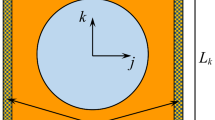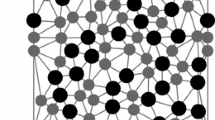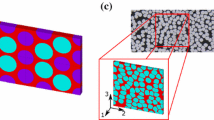Abstract
This paper reviews the most common formulations to obtain the compression strength of long fiber composites due to fiber buckling. This failure mode was first studied by Rosen (Fibre Composite Materials, pp. 37–45, 1965) who defined two different fiber buckling modes, extensional and transverse. Further studies improved the first model proposed by Rosen by defining with more accuracy the mechanics of the problem. Although each formulation use a different approach to solve the problem, all of them agree in the dependence of fiber buckling on three main parameters: matrix shear strength, fiber initial misalignments and volumetric participation of the fibers in the composite.
Once having described the different approaches used, and the parameters on which they depend, this paper describes a new formulation capable of obtaining the compression strength of composites taking into account the fiber buckling phenomenon. This formulation uses the serial/parallel mixing theory developed by Rastellini et al. (Comput. Struct. 86(9):879–896, 2008) to simulate the composite, and takes advantage of knowing the mechanical performance of the composite constituents to simulate the fiber buckling phenomenon. This is done with an homogenization procedure. It consists in introducing the interaction between fibers and matrix into their respective constitutive equations. The interaction between fiber and matrix takes into account fiber initial misalignments, its volumetric participation and the mechanical properties of both constituents.
The new formulation proposed is implemented in a finite element code, taking into account that fibers can have different misalignment levels, and that the composite behaves differently if it is under tensile or compression forces. The mechanical performance of the formulation proposed is studied with several finite element simulations of compressed composites. Finally, the correctness of the formulation is proved by comparing the numerical results with the experimental tests provided by Barbero and Tomblin (Int. J. Solids Struct. 33(29):4379–4393, 1996), Tomblin et al. (Int. J. Solids Struct. 34(13):1667–1679, 1997).
Similar content being viewed by others
References
Rosen B (1965) Fibre composite materials. Am Soc Metals, Metals Park, pp 37–45
Rastellni F, Oller S, Salomon O, Oñate E (2008) Composite materials non-linear modelling for long fibre reinforced laminates: Continuum basis, computational aspects and validations. Comput Struct 86(9):879–896
Barbero EJ, Tomblin JS (1996) A damage mechanics model for compression strength of composites. Int J Solids Struct 33(29):4379–4393
Tomblin JS, Barbero EJ, Godoy LA (1997) Imperfection sensitivity of fiber micro-buckling in elastic–nonlinear polymer–matrix composites. Int J Solids Struct 34(13):1667–1679
Welsh JS, Adams DF (1997) An experimental investigation of the mini-sandwich laminate as used to obtain unidirectional composite compression strengths. J Compos Mater 31(3):293–314
Barbero EJ (1998) Prediction of compression strength of unidirectional polymer matrix composites. J Compos Mater 32(5):483–502
Balacó de Morais A (1996) Modelling lamina longitudinal compression strength of carbon fibre composite laminates. J Compos Mater 30(10):1115–1131
Balacó de Morais A, Torres Marques A (1997) A micromechanical model for the prediction of the lamina longitudinal compression strength of composite laminates. J Compos Mater 31(14):1397–1412
Balacó de Morais A (2000) Prediction of the layer longitudinal compression strength. J Compos Mater 34(21):1808–1820
Drapier S, Grandidier JC, Potier-Ferry M (1999) Towards a numerical model of the compressive strength for long fibre composites. Eur J Mech A, Solids 18(1):69–92
Drapier S, Grandidier JC, Potier-Ferry M (2001) A structural approach of plastic microbuckling in long fibre composites: comparison with theoretical and experimental results. Int J Solids Struct 38(22–23):3877–3904
Parnes R, Chiskis A (2002) Buckling of nano–fibre reinforced composites: a re-examination of elastic buckling. J Mech Phys Solids 50(4):855–879
Akbarov SD, Kosker R (2001) Fiber buckling in a viscoelastic matrix. Mech Compos Mater 37(4):299–306
Kosker R, Akbarov SD (2003) Influence of the interaction between two neighboring periodically curved fibres on the stress distribution in a composite material. Mech Compos Mater 39(2):165–176
Jochum C, Grandidier JC (2004) Microbuckling elastic modelling approach of a single carbon fibre embedded in an epoxy matrix. Compos Sci Technol 64(16):2441–2449
Puig JM, Car E, Oller S (2001) Solution for the inelastic buckling of long fibre reinforced composite materials. In: Figuieras J, Juvanades L, Farias R, Balkema A (eds) CCC 2001—Composites in construction international conference, pp 119–124
Sánchez-Palencia E (1987) Homogenization techniques for composite media. In: Boundary layers and edge effects in composites. Springer, Berlin, pp 121–192
Oller S, Miquel J, Zalamea F (2005) Composite material behaviour using a homogenization double scale method. J Eng Mech 131(1):65–79
Gónzalez C, Llorca J (2007) Mechanical behavior of unidirectional fiber–reinforced polymers under transverse compression: Microscopic mechanisms and modeling. Compos Sci Technol 67(5):2795–2806
Zalamea F (2001) Tratamiento numérico de materiales compuestos mediante la teoría de homogeneización. Ph.D. thesis, Departament de Resistència de Materials i Estructures a l’Enginyeria (RMEE)—UPC. Directors: Juan Miquel Canet and Sergio Oller
Car E, Zalamea F, Oller S, Miquel J, Oñate E (2002) Numerical simulation of fiber reinforced composites—two procedures. Int J Solids Struct 39(7):1967–1986
Trusdell C, Toupin R (1960) The classical field theories. Handbuch der Physik, vol. 3(1). Springer, Berlin
Ortiz M, Popov E (1957) A physical model for the inelasticity of concrete. Proc R Soc Lond, Ser A 383:101–125
Ortiz M, Popov E (1982) Plain concrete as a composite material. Mech Mater 1:139–150
Green A, Naghdi P (1965) A dynamical theory of interacting continua. J Eng Sci 3:231–241
Oller S, Oñate E, Miquel J, Botello S (1996) A plastic damage constitutive model for composite materials. Int J Solids Struct 33(17):2501–2518
Car E (2000) Modelo constitutivo continuo para el estudio del comportamiento mecánico de los materiales compuestos. Ph.D. thesis, Departament de Resistència de Materials i Estructures a l’Enginyeria (RMEE)—UPC. Directors: Sergio Oller and Eugenio Oñate
Malvern LE (1968) Introduction to the mechanics of a continuous medium. Prentice-Hall, Englewood Cliffs
Lubliner J (1990) Plasticity theory. MacMillan & Co., New York
Oller S (2002) Dinámica no-lineal. CIMNE (Centro Internacional de Métodos Numéricos en Ingeniería), Barcelona
Car E, Oller S, Oñate E (2000) An anisotropic elasto plastic constitutive model for large strain analysis of fiber reinforced composite materials. Comput Methods Appl Mech Eng 185(2–4):245–277
Car E, Oller S, Oñate E (2001) A large strain plasticity model for anisotropic materials—composite material application. Int J Plast 17(11):1437–1463
Oller S, Neamtu L, Oñate E (1995) Una generalización de la teoría de mezclas clásica para el tratamiento de compuestos en serie/paralelo. In: París F, Cañas J (eds) MATCOMP 95, pp 433–438
Neamtu L, Oller S, Oñate E (1997) A generalized mixing theory elasto-damage-plastic model for finite element analysis of composites. In: Owen D, Oñate E, Hinton E (eds) Complas V—Computational plasticity, pp 1–5
Rastellini F, Oller S, Salomon O, Oñate E (2003) Advanced serial-parallel mixing theory for composite materials analysis. Continuum basis and finite element applications. In: Oñate E, Owen D (eds) COMPLAS 2003—Proceeding CD of the VII international conference on computational plasticity
Salomon O, Rastellini F, Oller S, Oñate E (2005) Fatigue prediction for composite materials and structures. In: Research N, technology organisation (RTO) (eds) Air vehicle technology: AVT-121. Symposium on the evaluation, control and prevention of high cycle fatigue
Rastellini F (2006) Numerical modelling of the constitutive non-linearity of composite laminates. Ph.D. thesis, Departament de Resistència de Materials i Estructures a l’Enginyeria (RMEE)—UPC. Directors: Sergio Oller and Eugenio Oñate
Martínez X, Oller S, Rastellini F, Barbat A (2008) A numerical procedure simulating RC structures reinforced with FRP using the serial/parallel mixing theory. Comput Struct 86(15–16):1604–1618
Martínez X, Oller S, Barbero E (2008) Study of delamination in composites by using the serial/parallel mixing theory and a damage formulation. In: Mechanical response of composites. Computational methods in applied sciences. Springer, Berlin
CIMNE: PLCd Manual. Non-linear thermomechanic finite element code oriented to PhD student education (1991–2008). Finite element code developed at CIMNE
Oller S, Oñate E, Oliver J, Lubliner J (1990) Finite element non-linear analysis of concrete structures using a plastic-damage model. Eng Fract Mech 35(1–3):219–231
Lubliner J, Oliver J, Oller S, Oñate E (1989) A plastic-damage model for concrete. Int J Solids Struct 25(3):299–326
Barbat AH, Oller S, Oñate E, Hanganu A (1997) Viscous damage model for Timoshenko beam structures. Int J Solids Struct 34(30):3953–3976
Mata P, Oller S, Barbat AH (2007) Static analysis of beam structures under nonlinear geometric and constitutive behaviour. Comput Methods Appl Mech Eng 196(45–48):4458–4478
Mata P, Oller S, Barbat AH (2008) Dynamic analysis of beam structures considering geometric and constitutive nonlinearity. Comput Methods Appl Mech Eng 197(6–8):857–878
Jones RM (1999) Mechanics of composite materials, 2nd edn. Taylor & Francis, Philadelphia
Timoshenko SP, Gere JM (1961) Theory of elastic stability, international student edn. McGraw-Hill, Tokyo
Lo KH, Chim ESM (1992) Compressive strength of unidirectional composites. J Reinf Plast Compos 11(8):838–896
Xu YL, Reifsnider KL (1993) Micromechanical modeling of composite compressive strength. J Compos Mater 27(6):558–572
Yurgartis SW (1987) Measurement of small angle fiber misalignment in continuous fiber composites. Compos Sci Technol 30(4):279–293
Paluch B (1996) Analysis of geometric imperfections affecting the fibers in unidirectional composites. J Compos Mater 30(4):454–485
Clarke AR, Archenhold G, Davidson NC (1995) A novel technique for determining the 3d spatial distribution of glass fibers in polymer composites. Compos Sci Technol 55(1):75–91
Wisnom M (2000) Size effects in Composites. In: Comprehensive composite materials, vol 5. Test methods, nondestructive evaluation and smart materials. Elsevier, London, pp 23–47
Grandidier JC, Ferron G, Potier-Ferry M (1992) Microbuckling and strength in long-fiber composites: theory and experiments. Int J Solids Struct 29(14–15):1753–1761
Guz AN, Lapusta YN (1999) Three-dimensional problems of the near-surface instability of fiber composites in compression (model of a piecewise-uniform medium)(survey). Int Appl Mech 35(7):641–670
Puig JM, Car E, Oller S (2002) Solución numérica para el pandeo inelástico de materiales compuestos reforzados con fibras largas. In: Análisis y cálculo de estructuras de materiales compuestos. CIMNE (Centro Internacional de Métodos Numéricos en Ingeniería), Barcelona, pp 295–320
Kachanov LM (1986) Introduction to continuum damage mechanics. Mechanics of elastic stability. Nijhoff, Dordrecht
Oliver J, Cervera M, Oller S, Lubliner J (1990) Isotropic damage models and smeared crack analysis of concrete. In: Mang H, Bicánić N (eds) Second international conference on computer aided analysis and design of concrete structures, pp 945–958
Oller S (2003) Simulación numérica del comportamiento mecánico de los materiales compuestos. CIMNE (Centro Internacional de Métodos Numéricos en Ingeniería), Barcelona
Naik NK, Tiwari SI, Kumar RS (2003) An analytical model for compresssive strength of plain wave fabric composites. Compos Sci Technol 63(5):609–625
Wang W, Shenoi RA (2004) Analytical solutions to predict flexural behaviour of curved sandwich beams. J Sandw Struct Mater 6:199–216
Hetényi M (1971) Beams on elastic foundation. Theory with applications in the field of civil and mechanical engineering. The University of Michigan Press, Ann Arbor
Oller S (2001) Fractura mecánica. Un enfoque global. CIMNE (Centro Internacional de Métodos Numéricos en Ingeniería), Barcelona
Timoshenko SP (1940) Strength of materials. Part I. Elementary theory and problems. Van Nostrand, New York
Martínez X, Oller S, Barbat A, Rastellini F (2007) New procedure to calculate compression strength of FRP using the serial/parallel mixing theory. In: FRPRCS-8—8th international symposium on fiber reinforced polymer reinforcement for concrete structures
Timoshenko SP (1940) Strength of materials. Part II. Advanced theory and problems. Van Nostrand, New York
Martínez X (2008) Micro-mechanical simulation of composite materials using the serial/parallel mixing theory. Ph.D. thesis, Departament de Resistència de Materials i Estructures a l’Enginyeria (RMEE)—UPC. Director: Sergio Oller
Hoffman JD (2001) Numerical methods for scientists and engineers. Dekker, New York
Author information
Authors and Affiliations
Corresponding author
Additional information
This work has been supported by the Spanish Ministry of Science and Innovation throughout the projects “RECOMP”, Ref. BIA2005-06952, “DECOMAR”, Ref. MAT2003-08700-C03-02 and “DELCOM”, Ref. MAT2008-02232/MAT; by the Spanish Ministry of Public Works project “Retrofitting and Reinforcement of Reinforced Concrete structures with Composite Materials”; by “AIRBUS” (Spain), Contract No. PBSO-13-06 “FEMCOM”, by “ACCIONA Infraestructuras” (Spain) throughout the projects “CETIC”, “Sphera” and “Prometeo”; by Agencia Española de Cooperación Internacional para el Desarrollo (AECID), Ref. A/012257/07; and by International Center for Numerical Methods in Engineering (CIMNE), Spain. All support is gratefully acknowledged.
Rights and permissions
About this article
Cite this article
Martinez, X., Oller, S. Numerical Simulation of Matrix Reinforced Composite Materials Subjected to Compression Loads. Arch Computat Methods Eng 16, 357–397 (2009). https://doi.org/10.1007/s11831-009-9036-3
Received:
Accepted:
Published:
Issue Date:
DOI: https://doi.org/10.1007/s11831-009-9036-3




